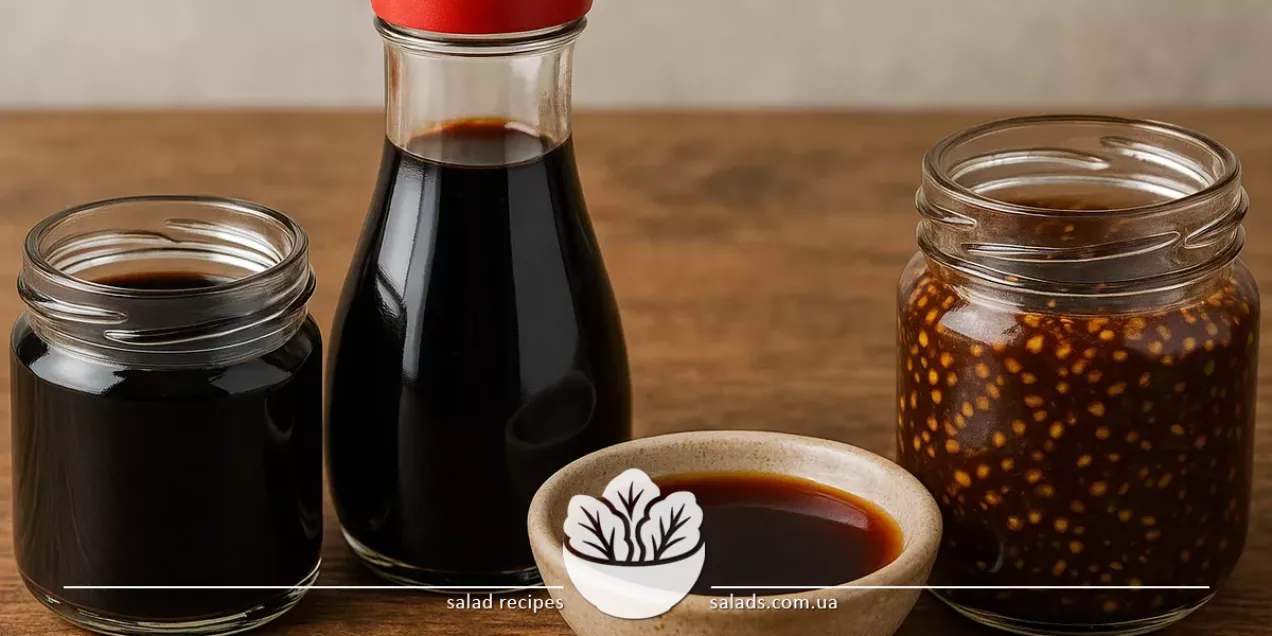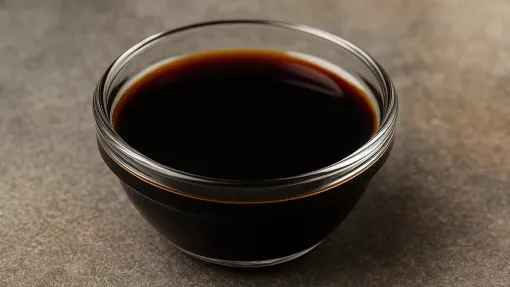Types of Soy Sauce

Types of soy sauce include a wide range of traditional and modern variations of one of the world's most famous sauces. It adds a salty umami taste to dishes, enhances aroma, and often replaces salt in recipes. Within the sauces category, soy sauce holds a special place thanks to its composition, versatility, and ability to adapt to various cuisines. Different types vary in color, thickness, and culinary use, allowing you to precisely adjust the flavor profile of any dish.
Different Types of Soy Sauce
Light, Dark, and Flavored Soy Sauces
Soy sauce is not a single product but a whole category of sauces that differ in color, consistency, composition, and culinary use. The most common is light soy sauce – thin, with a rich salty flavor and the distinctive aroma of fermented beans. It is a staple condiment in Chinese, Japanese, Korean, and other Asian cuisines. It's added to soups, stir-fries, noodles, and rice. Dark soy sauce is thicker, darker in color, and has a slightly sweet aftertaste. It is made through longer fermentation and often includes molasses or sugar. This sauce is ideal for marinades, stews, or when a deeper color is needed – for example, when cooking meat or onions in soy sauce for caramelization.
There are also specialty soy sauces with added shiitake mushrooms, ginger, garlic, or sesame. These versions have pronounced aromas and are mostly used as ready-made dressings or as a finishing touch in dishes. For example, mushroom soy sauce works well with noodles, while ginger soy sauce is perfect for salads or fish. In Japanese cuisine, types like “usukuchi” (light but very salty) and “tamari” (less salty, wheat-free, often used in gluten-free diets) are popular. Korea has its own version called “ganjang,” and Indonesia offers sweet, thick “kecap manis.” This variety allows precise flavor control, adjusting saltiness, aroma, and even color to give dishes more depth and richness.
Ingredients and Properties of Soy Sauce
Traditional soy sauce is made by fermenting soybeans, wheat, water, and salt. Fermentation gives the sauce its characteristic flavor dominated by umami – the fifth basic taste that enhances the perception of saltiness, sweetness, and aroma. The fermentation process can last from several weeks to a few months, depending on the type and regional production traditions. Naturally fermented soy sauce contains glutamic acid – an amino acid that enhances flavor without the need for artificial enhancers. It also contains potassium, magnesium, small amounts of iron, and antioxidants produced during fermentation.
Soy sauce can have a salt content of up to 14-16%, which is why it's often used instead of salt in many dishes. However, “low-sodium” versions with reduced salt content are increasingly available, making the product suitable for people with high blood pressure or dietary restrictions. These sauces retain aroma and flavor while reducing the load on the kidneys and cardiovascular system. Some manufacturers add preservatives, coloring, or caramel to deepen the color. High-quality soy sauces usually have a short ingredient list and are made naturally. For example, classic Japanese soy sauce contains only four ingredients and requires no additives. The composition also varies by region: Chinese soy sauce may be darker and thicker, Japanese versions are lighter and milder, and Korean sauces may include fermented components similar to apple cider vinegar or miso paste.
Culinary Uses of Different Types of Soy Sauce
Soy sauce is a versatile culinary ingredient – it’s added to both hot and cold dishes, used in marinades, dressings, sauces, and glazes. Its primary role is to deepen flavor, add umami notes, and balance sweet, sour, and bitter tastes. Light soy sauce is most often used in noodle, rice, vegetable, or protein-based dishes such as chicken, fish, or tofu. Dark soy sauce is favored for long-cooked dishes like braises, baked meals, or caramelization. Its thickness and rich color help create a glossy glaze, especially in recipes featuring pork, beef, or mushrooms. For example, dark soy sauce is excellent with grilled vegetables or sides made with olive oil and herbs.
Flavored soy sauces – with garlic, mushrooms, wasabi, or lime – are added to salads, dipping sauces, or spreads. In many modern recipes, soy sauce replaces salt, as it enhances other ingredients' flavors more effectively. It's also used in ramen broths, soups, and braised vegetables where rich flavor is desired. Combined with vinegar, honey, or chili paste, soy sauce becomes the base for complex dressings, for instance in salads or baked dishes. A simple example is a mix of soy sauce, sesame oil, and rice vinegar, used to marinate vegetables or prepare sauces for Asian meals. In gastronomy, it's important to consider not only flavor but also cooking method – light sauces are better for quick stir-frying, while dark ones suit braising or glazing. Each soy sauce type reveals its full potential only in the right culinary context.
Storage and Shelf Life of Soy Sauce
Soy sauce is a long-lasting product, especially when made using traditional fermentation methods without unstable ingredients. An unopened bottle can be stored at room temperature for 1-2 years, provided it’s kept in a dark place away from direct sunlight. After opening, the sauce should be refrigerated, where it retains its flavor and aroma for 3-6 months. Over time, opened soy sauce may lose aroma intensity or change taste, particularly if the bottle is left open or frequently exposed to air. Glass bottles with tight lids are preferable, as plastic can affect the flavor during extended storage.
Soy sauces with added ingredients – such as cucumber, mushrooms, herbs, or spices – have a shorter shelf life. They should be stored only in the fridge and ideally consumed within 2-4 weeks of opening. To preserve aroma and prevent spoilage, it's recommended not to pour sauce directly from the bottle into hot pans or pots – instead, use a separate spoon or bowl. Labeling usually includes not only the expiration date but also storage instructions. Following these guidelines helps avoid fermentation or oxidation, which compromise both flavor and safety. It’s also best not to mix old sauce remnants with fresh ones – even from the same brand. Maintaining proper temperature and hygiene during use ensures product quality and allows you to enjoy its flavor without health risks.
Soy Sauce in a Healthy Diet
Soy sauce is not only a tasty condiment but also a healthy alternative to regular salt in everyday meals. Thanks to natural fermentation and high umami content, even a small amount of sauce can significantly enhance a dish’s flavor. This allows for sodium reduction without sacrificing taste intensity. It’s particularly beneficial for people managing blood pressure or cardiovascular conditions. Traditionally fermented sauce contains antioxidants, enzymes, and amino acids that can support digestion and reduce oxidative stress. Additionally, soy sauce pairs well with vegetables, proteins, grains, and even fruits – making it a versatile component in a balanced diet.
In vegetarian and vegan cooking, soy sauce often serves as a flavor base to compensate for the absence of meat broth. For example, it can be combined with apples in caramelized glaze or with vegetable pastes to create complex sauces. In small quantities, it’s also suitable for children's meals – as long as salt content is monitored. Soy sauce is low in calories – about 10 kcal per tablespoon – so it doesn’t significantly increase a dish’s caloric value. For this reason, it's frequently included in healthy weight loss programs, intermittent fasting, or cleansing diets. With its wide range – from classic to low-sodium or flavored – everyone can find a soy sauce that suits their eating style. While it’s not a primary source of nutrients, moderate consumption enriches the diet and adds variety.
